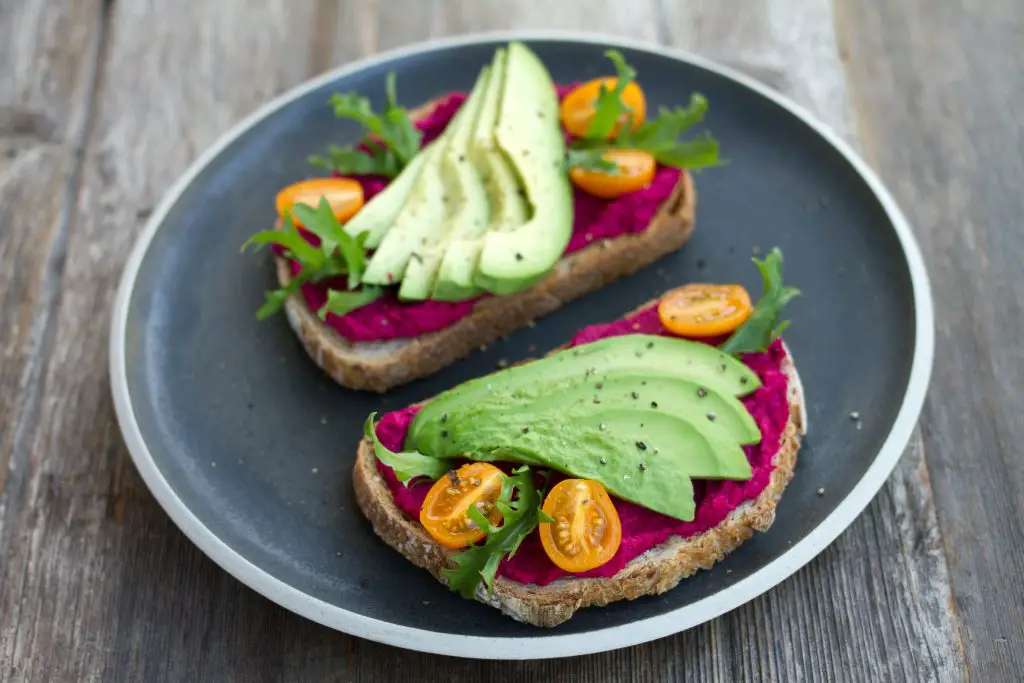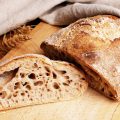Most of us hold the soft, pillowy texture of bread close to our hearts, despite the fact that it is very high in carbs. And also normally completely avoided on most weight loss diets. But what about sourdough bread? Is it good for weight loss?

Table of Contents
- What is Sourdough Bread?
- Is Sourdough Bread Good for You?
- Is Sourdough Bread Healthy?
- Is Sourdough Bread Good For Weight Loss?
- How to Make Sourdough Bread
- Healthy Sourdough Bread Recipes
- So is Sourdough Bread Good For Weight Loss?
- FAQ’s

Sourdough Cheddar and Onion Tartine
This beautiful, decadent cheddar tartine with fig jam, will quickly become a staple in your household. Complete with the secret element of sourdough bread, for that perfect tangy bite.
- Total Time: 18 minutes
- Yield: 8 slices 1x
Ingredients
- 1 medium onion
- 8 slices sourdough bread
- 1 tbsp extra virgin oil
- 2 tbsp chopped walnuts
- fig jam
- camembert cheese
- salt and pepper
Instructions
- In a large pan over medium heat, add oil and onion
- Cook for about 15 minutes, until the onions are golden brown and very tender
- Lightly toast your bread in a toaster or oven. The bread should become crispy
- Lay a sheet of foil in a tray and add bread slices
- Spoon some caramelized onions to cover the bread
- Add about two to three pieces of camembert cheese on top, in the center, so that when it melts it can spready beautifully
- Top with walnuts, using a knife and your fingers. Scatter small globs of fig jam
- Broil in the oven for 3 minutes
- Season with salt and pepper
- Cook Time: 18 mins
- Category: bread
- Diet: Vegetarian
What is Sourdough Bread?
Sourdough bread is a type of bread in which the leavening agent is a sourdough starter. The word “sourdough” refers to the process of aging yeast over time, rather than using fresh yeast.
Sourdough starters are made by combining water and flour together with wild yeast from the air. The mixture is left out at room temperature for several days until it begins to bubble and smell sour.
When you’re ready to bake with it, simply add it into your dough along with additional flour and other ingredients.
Sourdough Bread vs Whole Wheat Bread
Sourdough contains beneficial bacteria. Good and bad bacteria are both present in our bodies, but the ratio of good to bad is important for overall health.
Probiotic foods contain large amounts of good bacteria that can help keep your system balanced. Sourdough bread is one of these probiotics, making it a healthy alternative to regular whole wheat bread. If you’re looking for ways to increase your intake of probiotics and improve your digestive health, then sourdough bread is the one to go for.
There are many reasons why sourdough is a better choice than whole wheat bread. While both of these types of bread are high in fiber, sourdough has the added benefit of being an antimicrobial food, meaning that it is able to protect your body from harmful bacteria and fungi.
Sourdough bread also contains a higher content of lactic acid compared to other types of bread which can aid in digestion. Lactic acid is produced by the fermentation process and helps break down carbs, fat and protein.
While both breads are equally delicious, sourdough bread contains more fiber and has a lower glycemic index than whole wheat bread. It’s also made from natural yeast rather than commercial yeast with some of the same health benefits as whole wheat bread.
Is Sourdough Bread Good for You?
Based on the nutritional information, sourdough bread is a healthy choice.
Sourdough bread is low in calories, fat and sugar, with only 1g of saturated fat per slice. It also contains a good amount of fiber (2g per slice), which helps you feel full and satisfied while contributing to digestion. Fiber is essential for maintaining a healthy gut and promoting regular bowel movements. It also helps to slow down the absorption of sugar into the bloodstream, reducing the risk of blood sugar spikes and crashes.
Sourdough has more protein than regular white or brown bread at 12% per 100g serving. Protein is essential for building and repairing tissues in the body, as well as maintaining healthy muscles, bones, and skin. The higher protein content in sourdough bread makes it a more filling and satisfying option compared to other types of bread.
Sourdough is high in B vitamins such as riboflavin (B2), niacin (B3), folate and thiamin (B1). These vitamins play important roles in energy metabolism, nerve function, and the production of red blood cells. They also contribute to healthy skin, hair, and nails.
Sourdough is also naturally rich in iron which helps prevent anemia by carrying oxygen around the body efficiently. Iron is crucial for the production of hemoglobin, a protein in red blood cells that transports oxygen from the lungs to the rest of the body. Adequate iron intake is especially important for women of childbearing age, as they are at a higher risk of iron-deficiency anemia.
In addition to its nutritional benefits, sourdough bread is often easier to digest than other types of bread due to the fermentation process involved in its production. This process breaks down some of the gluten and other complex carbohydrates, making them more accessible to the body’s digestive enzymes. As a result, sourdough bread may be a better option for those with mild gluten sensitivities or digestive issues.
Overall, sourdough bread is a nutritious and delicious choice that can be enjoyed as part of a balanced diet. Its unique flavor profile and texture also make it a versatile ingredient in a variety of dishes, from sandwiches to toast to croutons.
Is Sourdough Bread Healthy?
Sourdough bread is low in fat, sodium, and calories compared to other types of breads like white bread or wheat toast. It contains more fiber compared to other types of bread, which means it makes you feel fuller after eating it so you won’t be reaching for another piece soon after.
The high protein content also helps reduce cravings by making you feel fuller longer. The combination of fiber and protein in sourdough bread makes it a satisfying and nutritious choice for those looking to maintain a healthy weight.
Additionally, sourdough contains vitamin B, which helps boost metabolism, as well as reduces stress levels by releasing endorphins into our bodies when eaten regularly.
Another benefit worth mentioning is that sourdough has been shown to contain antioxidants such as apigenin and ferulic acid, both known for their cancer-preventing properties.
Furthermore, the fermentation process used to make sourdough bread can make it easier to digest for some people compared to other types of bread. This may be particularly beneficial for those with mild gluten sensitivities or digestive issues.
Blood Sugar and Sourdough Bread
Sourdough bread has gained popularity not only for its tangy flavor and chewy texture but also for its potential health benefits, particularly in relation to blood sugar control. The fermentation process used in making sourdough bread can help lower its glycemic index, which means it may have a less significant impact on blood sugar levels compared to regular bread.
During the fermentation process, the bacteria and yeast break down some of the carbohydrates in the dough, resulting in a lower amount of available sugars. This slower digestion and absorption of carbohydrates can lead to a more gradual rise in blood sugar levels, which is especially beneficial for individuals with diabetes or those looking to maintain stable blood sugar levels.
However, it’s important to note that the glycemic impact of sourdough bread can vary depending on factors such as the type of flour used, the duration of fermentation, and individual metabolic responses.
Fiber and Sourdough Bread
Sourdough bread, when made with whole grain flours, can be an excellent source of dietary fiber. Fiber is an essential nutrient that helps maintain digestive health, promoting feelings of fullness, and supporting overall well-being.
The fermentation process used in making sourdough bread can enhance its fiber content. During fermentation, the bacteria and yeast break down some of the complex carbohydrates, including oligosaccharides and resistant starches, which can then function as prebiotic fibers. These prebiotic fibers serve as food for the beneficial bacteria in the gut, helping to support a healthy gut microbiome.
Whole grain sourdough bread, in particular, is a great choice for those looking to increase their fiber intake. Whole grains retain the bran and germ of the wheat kernel, which are rich in fiber, vitamins, and minerals. Incorporating whole grain sourdough bread into a balanced diet can contribute to meeting daily fiber recommendations and promoting digestive health.
Is Sourdough Bread Good For Weight Loss?
Sourdough bread can be a good option for weight loss due to several factors.
First, it is typically lower in calories compared to other types of bread. This means that you can enjoy sourdough bread without significantly increasing your calorie intake, which is crucial when trying to lose weight.
Moreover, sourdough bread contains more fiber than regular white or whole meal varieties. Fiber helps promote the feeling of fullness and satiety, which can help you control your appetite and reduce overall calorie consumption. By feeling fuller for longer periods, you may be less likely to snack on unhealthy foods between meals, making it easier to stick to your diet plan.
However, it’s important to note that sourdough should still be consumed in moderation as part of a balanced diet and combined with regular physical activity for optimal weight loss results.
Possible Drawbacks of Sourdough Bread for Weight Loss
Firstly, sourdough bread is still a calorie-dense food. Depending on the flour used and the size of the slice, sourdough bread can contain a significant amount of calories. Consuming too many calories, even from healthier sources like sourdough bread, can lead to weight gain if not balanced with overall energy expenditure.
Secondly, sourdough bread is often made with refined flour, which has been stripped of its bran and germ, leaving only the starchy endosperm. This process removes many of the nutrients and fiber found in whole grain flour. Consuming refined grains has been associated with an increased risk of obesity and related health issues.
Additionally, some commercially produced sourdough bread may contain added sugars, oils, or other ingredients that can contribute to weight gain. It’s important to read labels carefully and choose sourdough bread made with minimal, whole-food ingredients.
Lastly, individual responses to sourdough bread can vary. Some people may find that consuming sourdough bread, even in moderation, leads to bloating, digestive discomfort, or other issues that can make weight loss more challenging.
How to Make Sourdough Bread
The first thing you need to know about sourdough bread is that it’s made with a starter. This is a mixture of flour and water that is left to ferment for several days, until it has a sour smell and slightly sweet taste. The starter can then be fed and left to ferment again, resulting in another batch of starter that will produce even better dough the next time around.
You’ll also need some flour—most people use white flour but some prefer whole grain. Mix one cup of warm water with three cups of flour in a large bowl until it forms into an elastic ball; this takes about five minutes by hand or two minutes in an electric mixer fitted with dough hooks.
Once your dough has come together, cover it with plastic wrap and let sit at room temperature for 24 hours so that fermentation begins; if possible place your bowl on top of a heating pad set to low so that the temperature remains constant throughout this process.
Healthy Sourdough Bread Recipes
Sourdough is a popular kind of bread, so you’re probably already familiar with it. But a traditional loaf isn’t the only way for you to enjoy this bread.
These recipes are all healthy because they don’t use any processed ingredients or excess sugar. And they’re so so easy to make, tasting amazing!
Sourdough Cinnamon Rolls
If you love cinnamon rolls then you’ll love this healthier sourdough version!
For this recipe you’ll need:
- 1 cup warm water (110 Fahrenheit)
- 2 tbsp active dry yeast or 1 tbsp instant yeast
- 1/4 cup granulated sugar
- 2 cups all-purpose flour
- In a large bowl whisk together the water, yeast and ½ teaspoon of the sugar. Let sit until foamy, 5 to 10 minutes. Add 1½ cups of flour and mix well; then add another 1½ cups flour and mix again until smooth.
- Transfer to a floured work surface. Knead until smooth but still slightly sticky, adding more flour as needed if it is too sticky or not covering your hands when kneading – about 8 minutes for hand-kneaded dough; about 5 minutes for machine-mixed dough at medium speed using a stand mixer fitted with a dough hook attachment.
- Shape into an oblong rectangle on top of parchment paper. Cover loosely with plastic wrap or dampened tea towel; let rise in draft-free place until puffy and almost doubled in size – between 30 minutes to 1 hour depending on room temperature.
- Brush lightly with beaten egg white before baking so that tops won’t be too dark. Sprinkle generously with granulated sugar mixture just before baking.
- Bake at 350°F(180°C)for 15–20 minutes until golden brown around edges. Cool completely before frosting if desired.
- Store at room temperature wrapped tightly in plastic wrap up to 3 days or freeze up to 3 months sliced thickly between pieces of waxed paper placed inside gallon Ziploc bags. Thaw overnight in refrigerator before serving cold

Full blog: Delicious Sourdough Discard Cinnamon Rolls
Sourdough Sandwich Bread
Sourdough sandwich bread is one of the easiest bread recipes you can make and it doesn’t take much time at all. The only ingredients that you need are flour, salt and water. This recipe makes 2 loaves or 1 loaf in a bread machine.
- Mix together flour and water until well combined into dough ball shape.
- Cover with plastic wrap or lid on top of bowl then let sit for 12-24 hours at room temperature until doubled in size
- Once risen take out of bowl onto floured surface, knead for about 5 minutes until smooth feeling with no dry bits left over from mixing process before letting rise again about another hour depending on how warm/hot environment is where they’re sitting while they rise. If using whole wheat flour just keep kneading until mixed well enough not that there’s no white visible anymore when looking down through cracks between fingers while holding onto sides while pulling apart into thin strands.
- Then repeat steps 1-5 again after first rise finished.

Full blog: Sourdough Breakfast Sandwich
Cheddar and Onion Tartine
This beautiful, decadent cheddar tartine with fig jam, will quickly become a staple in your household. Complete with the secret element of sourdough bread, for that perfect tangy bite.
Here’s what you’ll need:
- 1 medium onion
- 8 slices sourdough bread
- 1 tbsp extra virgin oil
- 2 tbsp chopped walnuts
- Fig jam
- Camembert cheese
- Salt and pepper
- In a large pan over medium heat, add oil and onion
- Cook for about 15 minutes, until the onions are golden brown and very tender
- Lightly toast your bread in a toaster or oven. The bread should become crispy
- Lay a sheet of foil in a tray and add bread slices
- Spoon some caramelised onions to cover the bread
- Add about two to three pieces of camembert cheese on top, in the centre, so that when it melts it can spready beautifully
- Top with walnuts, using a knife and your fingers. Scatter small globs of fig jam
- Broil in the oven for 3 minutes
- Season with salt and pepper
Sourdough Pizza Crust
For a delicious and healthy pizza night, try this sourdough pizza crust recipe:
- 1 cup sourdough starter
- 1/2 cup warm water
- 2 1/2 cups all-purpose flour
- 1 tsp salt
- 1 tbsp olive oil
- In a large bowl, mix the sourdough starter, water, flour, and salt until well combined.
- Knead the dough on a floured surface for about 5 minutes until smooth and elastic.
- Place the dough in an oiled bowl, cover, and let rise for 4-6 hours or until doubled in size.
- Punch down the dough and shape into a pizza crust on a greased baking sheet or pizza stone.
- Brush with olive oil and add your favorite toppings.
- Bake at 450°F for 15-20 minutes until the crust is golden brown and crispy.
Enjoy your healthy and flavorful sourdough pizza!
Sourdough Banana Bread
This sourdough banana bread is a perfect way to use up overripe bananas and sourdough discard:
- 1 cup sourdough starter
- 3 ripe bananas, mashed
- 1/4 cup melted butter
- 1/2 cup honey or maple syrup
- 2 eggs
- 1 tsp vanilla extract
- 1 1/2 cups whole wheat flour
- 1 tsp baking soda
- 1/2 tsp salt
- 1/2 cup chopped walnuts (optional)
- Preheat the oven to 350°F and grease a 9×5 inch loaf pan.
- In a large bowl, mix the sourdough starter, mashed bananas, melted butter, honey, eggs, and vanilla until well combined.
- In a separate bowl, whisk together the flour, baking soda, and salt.
- Stir the dry ingredients into the wet ingredients until just combined. Fold in the walnuts if using.
- Pour the batter into the prepared loaf pan and bake for 50-60 minutes, until a toothpick inserted into the center comes out clean.
- Let cool in the pan for 10 minutes before removing and slicing.

So is Sourdough Bread Good For Weight Loss?
Sourdough bread provides an abundance of health benefits, including fiber and B vitamins, as well as beneficial microorganisms that help digest the carbs in your body. Consequently, sourdough bread is probably the better choice for those who want to lose weight. But remember – everything in moderation and a balanced diet is key, along with exercise!
So, there you go!
FAQ’s
Is it OK to Eat Sourdough Bread Everyday?
Yes, as sourdough contains a variety of vitamins and nutrients which are beneficial to your day to day health.
Is Sourdough Bread Fattening?
Sourdough bread is the healthiest option to choose for weight loss. It’s better at assisting the body in digesting carbohydrates compared to other kinds of bread.
Which Bread is Best for Weight Loss?
There are a variety of breads that you can eat when following a diet, and some of these include Sourdough, Ezekiel, Rye, Wheat, and more.






